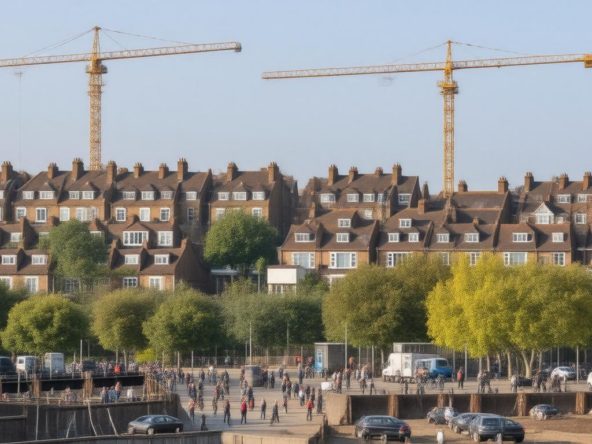Local authority housing plays a crucial role in the provision of affordable living solutions for individuals and families across the UK. With increasing housing costs and a growing population, understanding how local authority housing operates becomes essential. This article will provide a comprehensive overview of local authority housing, including eligibility criteria, application processes, available types, benefits, and challenges associated with living in local authority housing. Whether you are a young professional looking for your first home or a family in need of more space, this guide aims to equip you with the necessary information to navigate the local authority housing landscape effectively.
Key Takeaways
- Local authority housing provides affordable living options across the UK.
- Eligibility criteria often include income limits and residency requirements.
- The application process for local authority housing can vary by region and needs careful attention.
- There are various types of local authority housing, including social housing and council flats.
- Living in local authority housing offers benefits such as stability but may also come with certain challenges.
Understanding Local Authority Housing: An Overview
Local authority housing, often referred to as council housing, plays a crucial role in the provision of affordable accommodation across various communities in the UK. It is a form of public housing that is owned and managed by local councils, aimed at offering essential support to those in need, particularly low-income families and individuals who may struggle to access private rentals (Shelter, 2020). The system emerged in the post-war era, with the objective of addressing housing shortages and providing safe, quality homes for residents. Over the years, local authority housing policies have evolved, with measures to improve living standards, such as implementing energy-efficient solutions and upgrading existing properties (Department for Communities and Local Government, 2018). Despite facing challenges—like budget constraints and the ongoing housing crisis—local authorities continue to be integral in shaping housing strategies and offering viable solutions that bridge the gap between demand and supply in the housing market (National Housing Federation, 2021). Understanding the framework and functions of local authority housing is essential for appreciating its impact on community development and the overall wellbeing of residents.
Eligibility Criteria for Local Authority Housing
Local authority housing is provided by local councils to ensure that individuals and families have access to affordable homes. The eligibility criteria for local authority housing can vary depending on the specific local authority policies, but generally, applicants must meet certain conditions. Firstly, applicants typically need to reside in the area and often have to demonstrate a local connection to justify their application. Additionally, applicants may be required to meet specific income thresholds to ensure that thehousing is prioritised for those in greatest need. Moreover, individuals with certain vulnerabilities, such as those with disabilities, elderly individuals, or those facing homelessness, may receive higher priority on the housing list. It is essential for applicants to provide supporting evidence, including identification and financial information, to complete their application effectively (Shelter, 2021). Local authorities also conduct a housing needs assessment to gauge the demand for housing and to allocate resources accordingly. Understanding and meeting these criteria is crucial for individuals looking to secure local authority housing.
‘The essence of a successful city is a deep commitment to the public good—and that means involving local authorities to promote affordable living that uplifts the community as a whole.’ – Unknown
How to Apply for Local Authority Housing
Applying for local authority housing is a structured process that varies slightly depending on the area in which you are seeking accommodation. The first step is to determine your eligibility, which typically involves factors such as income, current living conditions, and residency status (UK Government, 2022). Once you establish that you qualify, you can proceed with your application, which usually involves completing a housing application form provided by your local council. This form will require detailed information, including personal details, current housing situation, and any specific needs you may have (Shelter, 2023). After submitting the application, it will be assessed, and you may be invited for an interview to discuss your needs further. Depending on your circumstances, you may be placed in a priority banding system, which can affect how promptly you receive an offer for housing (NHS Digital, 2021). It is essential to keep your information up to date and respond quickly to any correspondence from your local authority to facilitate the process.
Types of Local Authority Housing Available
Local authority housing encompasses various forms of accommodation provided by local government authorities to meet the housing needs of residents. Typically, the main types of local authority housing include council houses, which are rented properties owned by the council, providing affordable homes to low-income families. Additionally, housing associations offer a similar service, often managing buildings for tenants at reduced rates, focusing on social housing initiatives. Furthermore, local authorities may also engage in the provision of temporary accommodation, designed for individuals or families facing imminent homelessness, often offering vital support during crises. As housing demand changes, some councils are exploring innovative models such as shared ownership schemes, allowing residents to purchase a partial stake in a property while paying rent on the remaining share. Overall, the diversity of local authority housing is pivotal in addressing inequality in housing access and promoting community stability.
Benefits of Living in Local Authority Housing
Living in local authority housing presents a myriad of benefits that significantly contribute to an individual’s quality of life. Firstly, one of the most prominent advantages is affordability; local authority housing is typically more cost-effective compared to private rentals, which can alleviate financial pressures on residents (Department of Housing, 2021). This affordability often allows families to allocate funds towards education, health care, and other necessities. Additionally, local authority housing often comes with a degree of stability, providing long-term tenancy options that can foster a greater sense of community and security among residents (Shelter, 2023). Furthermore, many local authority housing schemes include access to support services and community facilities, which not only enhance social cohesion but also provide residents with various opportunities for social engagement and assistance (Crisis, 2022). The management of these properties also tends to be overseen by governmental entities, ensuring that housing standards are maintained and residents’ rights are protected (Local Government Association, 2023). Overall, local authority housing not only addresses the pressing need for affordable living options but also enriches the lives of its residents through stability, community integration, and support services.
Feel free to contact us via WhatsApp, social media, or email.
Always find the best rooms to rent & HMOs for sale in the UK at HMO Reporter.






